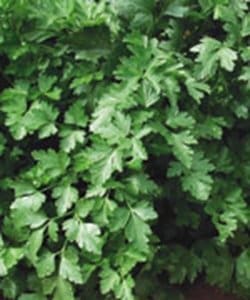
My grandfather always had a row of parsley (Petroselinum crispum) in his garden, and sprigs were cut each day for a small crystal vase on the dining table. His ritual was to munch parsley stems as a digestive at the end of dinner. It’s no surprise that parsley is my favourite herb, but I’m not interested in the decorative curly type he grew. I want the robust flat-leaf varieties that are full of pungent mint-like flavour.
This kind of parsley is easy to find in Italian markets, but I like to have some of my own plants in the growing season, because the flavour is boldest when fresh from the garden. I grow ‘Giant of Italy’ (johnnyseeds.com), an extra-large parsley you won’t fail to notice. The plants stand 18 inches (45 cm) tall, with thick, crisp stems and large flat, deep green leaves. Other Italian parsley choices are ‘Large Leaf Italian’ and ‘Gigante Italian’ (stokeseeds.com). There’s nothing subtle about these parsleys, and they definitely have a strong presence in pesto sauces and tabbouleh salads.
Parsley seed is slow to germinate, about 21 days when started indoors in early April and five to six weeks when planted in the garden. (Seed germinates best after chilling overnight in the refrigerator.) If you sow a few quick germinating radish seeds in the parsley rows, you’ll be able to remember where the parsley was sown. For strong plants, thin seedlings to 10 inches (25 cm) apart to allow plants room to develop stocky stems. Parsley grows best in sun to part shade; it also grows well in containers.
Parsley seems to have found compatible associations with other herbs. Chervil (Anthriscus cerefolium) is a rare treat seldom seen in food shops. Its delicate stems and leaves, and fragile flavour are incompatible with even the briefest storage on the chilled shelves of supermarkets. Chervil is an ingredient in the basic French fines herbes mixture of parsley, chervil, chives and tarragon or lavender. (Of course, there are many versions of the fines herbes mixture, and yours might be the best one.)
Fresh chervil, straight from the garden, tastes like a sweet pairing of parsley and anise. Its fragile flavour won’t withstand cooking or drying, so it’s always used fresh, scattered on foods at the last moment. It never fails to spike up a leaf lettuce salad. The chervil seed I look for is flat-leaf ‘Vertissimo’ Brussel’s winter strain (damseeds.com). It grows 18 inches (45 cm) tall and is darker green and more resilient than the curled-leaf variety.
Chervil likes cool, moist soil in part shade, and will sometimes self-seed the following year. It’s best grown in spring and autumn, planted by sprinkling seed directly onto moist soil in early May or late August. Cover it with just a light sifting of compost, and keep seed moist while it germinates.
Then there is ‘Par-cel’ (Apium graveolens Secalinum Group), a mysterious combination of parsley and celery, described as curled-leaf cutting celery, but without thick crunchy stems. ‘Par-cel’ (johnnyseeds.com) is a strain traced back to the time of the Great Pharaohs. The finely cut parsley-like leaves are a hint that it’s included in the genetic history of this salad plant, but the parsley may have been overwhelmed by the stronger celery flavour. I haven’t grown it, but suspect parsley genes have worked their way into the plant. Like Italian parsley and French chervil, ‘Par-cel’ likes part shade and moist soil.
These three plants belong together, and will be happy sharing quarters in a cool corner of my garden this spring.

Hello Judith: I have passed on this tip for speeding up the germination of parsley seeds to many, many people. I got the tip from Thalassa Cruso who had a gardening program on PBS many years ago. She was an English-raised gardener and archeologist who lived and gardened in Boston. When sowing parsley seeds outdoors, sprinkle the seeds along the row then pour over them a kettle of boiling water, covering the seeds while the soil is still steaming. Extreme though it may seem, it results in rapid and almost 100% germination.
Keep on with your excellent articles, I am going to try the micro clover on the bare spots next to the street on my lawn this spring -thanks. Jennifer W. Richmond Hill
Jennifer,
Thanks for the good information about germinating parsley seed sown outdoors. Thalassa Cruso is one of my all-time favourite garden writers, and it’s a loss not to have her with us anymore. But I do have all her books!– Judith